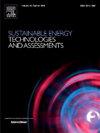基于人工智能与生命周期耦合模型的光伏发电碳减排与可持续碳金融潜力评价
IF 7
2区 工程技术
Q1 ENERGY & FUELS
Sustainable Energy Technologies and Assessments
Pub Date : 2025-08-29
DOI:10.1016/j.seta.2025.104528
引用次数: 0
摘要
光伏(PV)发电的典型设计寿命为25年,由于其显著的长期清洁电力生产,已成为传统火力发电的一个有前途的替代方案。然而,很少有人对将光伏纳入新兴碳金融市场的前景进行全面评估,以实现经济和生态效益的最大化。在人工智能和遥感技术蓬勃发展的背景下,本研究提出了“遥感提取-生命周期评估-碳金融潜力分析”的系统、可扩展的方法框架,以全面考察光伏发电的规模、分布、碳足迹、碳减排和经济效益。在能源转型需求迫切、碳金融市场活跃的背景下,我们选择了中国长三角地区作为案例研究对象。结果表明,所提出的多方法框架具有令人满意的准确度与效率平衡,提取精度超过94%,基于云平台的快速处理,以及方便的模块化评估工作流。到2020年,该地区的光伏建设面积为577平方公里,在25年的光伏生命周期内,将实现3.67亿吨二氧化碳的减排效益和8056.5亿元人民币的碳金融潜力。此外,这些以前很少被认识到的实质性利益的独特空间格局表明,有必要根据具体的当地条件利用光伏驱动的收益。通过量化光伏产业的多方面贡献,这项跨学科研究旨在促进贸易商和政策制定者在市场扩张和气候应对方面的开创性实践,从而实现经济上有益和环境上可持续的途径。本文章由计算机程序翻译,如有差异,请以英文原文为准。
Evaluation of carbon emission reduction and sustainable carbon finance potential in Photovoltaic power generation by Coupling Artificial Intelligence and life cycle model
With a typical designed lifespan of 25 years, Photovoltaic (PV) power has become a promising alternative solution to traditional thermal power generation due to its significant long-term clean electricity production. However, few efforts have been made to thoroughly evaluate the prospects of integrating PV into the emerging carbon financial markets to maximize both economic and ecological benefits. Given the burgeoning AI and remote sensing, this study proposed a systematic and scalable methodological framework of “Remote Sensing Extraction − Life Cycle Assessment − Carbon Finance Potential Analysis” to comprehensively investigate the scale, distribution, carbon footprint, carbon reduction, and economic performance of PV. With urgent energy transition needs and a vibrant carbon finance market, the Yangtze River Delta region of China was then selected for a case study. The results indicate that the proposed multi-method framework exhibits a satisfactory accuracy-efficiency balance, with over 94 % extraction accuracy, rapid cloud platform-based processing, and a convenient modular evaluation workflow. With a PV construction area of 577 km2 in 2020, the region will achieve an emission reduction benefit of 367 Mt CO2 and a carbon financial potential of RMB 805.65 billion over a 25-year PV life cycle. Moreover, the distinct spatial pattern of these previously little-recognized substantial benefits demonstrates the necessity of leveraging PV-driven yields according to specific local conditions. By quantifying the multifaceted contribution of the PV industry, this interdisciplinary study aims to facilitate pioneering practices of market expansion and climate response among traders and policymakers, thereby enabling an economically beneficial and environmentally sustainable pathway.
求助全文
通过发布文献求助,成功后即可免费获取论文全文。
去求助
来源期刊

Sustainable Energy Technologies and Assessments
Energy-Renewable Energy, Sustainability and the Environment
CiteScore
12.70
自引率
12.50%
发文量
1091
期刊介绍:
Encouraging a transition to a sustainable energy future is imperative for our world. Technologies that enable this shift in various sectors like transportation, heating, and power systems are of utmost importance. Sustainable Energy Technologies and Assessments welcomes papers focusing on a range of aspects and levels of technological advancements in energy generation and utilization. The aim is to reduce the negative environmental impact associated with energy production and consumption, spanning from laboratory experiments to real-world applications in the commercial sector.
 求助内容:
求助内容: 应助结果提醒方式:
应助结果提醒方式:


